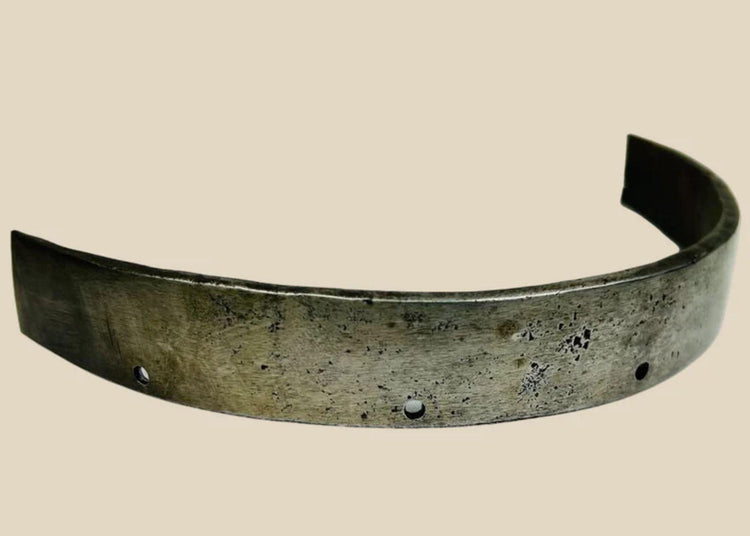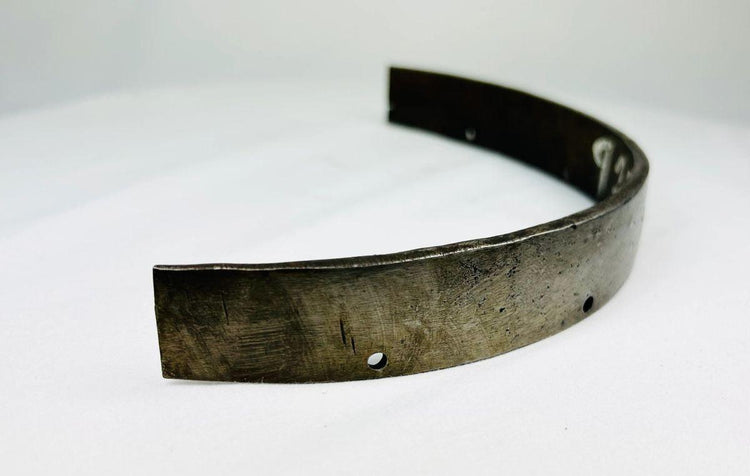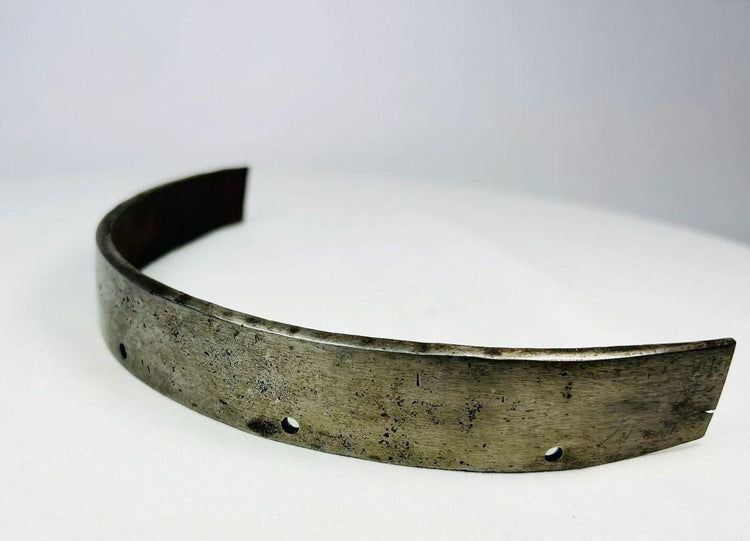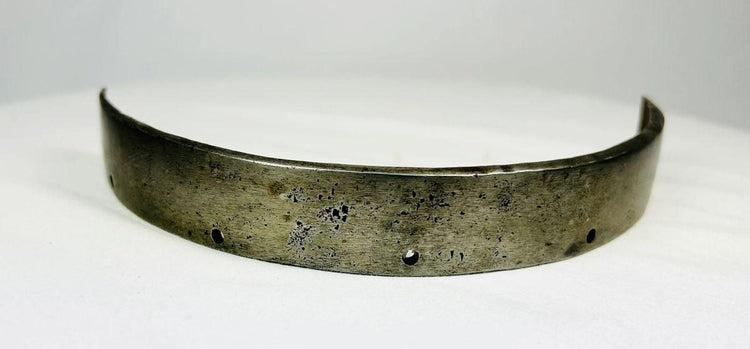European Defensive Armor Segment | Heavy Forged Steel Band from Siege Armor | 17th Century
Description
More
Less
Historical Context & Origin
Region: Europe
Material: Forged heavy steel
Period: 17th Century (c. 1600s)
Description
This formidable steel armor band dates to the 17th century, an era defined by the rise of firearms and the brutal realities of siege warfare. Likely originating from Europe, it would have been an essential part of heavy defensive or siege armor, designed to withstand intense combat conditions. Its thick, curved steel construction suggests that it reinforced vulnerable areas of the body or strengthened larger armor assemblies. Evenly spaced perforations indicate that it was riveted or fastened to adjoining armor lames, allowing flexibility while maintaining strong protection. Tool marks and surface wear testify to the hand-forged craftsmanship of period armorers and the practical battlefield use of the piece.
Features
- Thick forged steel construction for maximum impact resistance
- Curved form for body protection or reinforcement of armor assemblies
- Evenly spaced perforations for fastening to adjoining elements
- Subtle tool marks reflecting hand craftsmanship of the 17th century
- Natural aged patina with surface wear from prolonged use
Cultural Significance
Siege armor was a specialized form of protection, heavier and more reinforced than standard field armor, designed for prolonged combat during fortress assaults and defenses. This band exemplifies the technological adaptation of armorers to evolving warfare, where blunt force trauma, crossbow bolts, and projectile strikes required stronger protection. Beyond its practical role, it represents the ingenuity and resilience of European soldiers and craftsmen during one of the most turbulent military eras.
Condition
The armor band displays a rich, naturally aged patina with minor pitting and surface wear consistent with extensive use in combat conditions. Despite its age, the piece remains structurally intact and stable, preserving both its form and historical authenticity. The wear enhances its value as a genuine relic of 17th-century warfare.
Dimensions (approximate)
Length: 7 in
Age
Over 350 years old
Learn More
Explore the Rise and Fall of Steel Armor Through History
Discover More Historic Armor Pieces in Our Curated Collection
Description
Historical Context & Origin
Region: Europe
Material: Forged heavy steel
Period: 17th Century (c. 1600s)
Description
This formidable steel armor band dates to the 17th century, an era defined by the rise of firearms and the brutal realities of siege warfare. Likely originating from Europe, it would have been an essential part of heavy defensive or siege armor, designed to withstand intense combat conditions. Its thick, curved steel construction suggests that it reinforced vulnerable areas of the body or strengthened larger armor assemblies. Evenly spaced perforations indicate that it was riveted or fastened to adjoining armor lames, allowing flexibility while maintaining strong protection. Tool marks and surface wear testify to the hand-forged craftsmanship of period armorers and the practical battlefield use of the piece.
Features
- Thick forged steel construction for maximum impact resistance
- Curved form for body protection or reinforcement of armor assemblies
- Evenly spaced perforations for fastening to adjoining elements
- Subtle tool marks reflecting hand craftsmanship of the 17th century
- Natural aged patina with surface wear from prolonged use
Cultural Significance
Siege armor was a specialized form of protection, heavier and more reinforced than standard field armor, designed for prolonged combat during fortress assaults and defenses. This band exemplifies the technological adaptation of armorers to evolving warfare, where blunt force trauma, crossbow bolts, and projectile strikes required stronger protection. Beyond its practical role, it represents the ingenuity and resilience of European soldiers and craftsmen during one of the most turbulent military eras.
Condition
The armor band displays a rich, naturally aged patina with minor pitting and surface wear consistent with extensive use in combat conditions. Despite its age, the piece remains structurally intact and stable, preserving both its form and historical authenticity. The wear enhances its value as a genuine relic of 17th-century warfare.
Dimensions (approximate)
Length: 7 in
Age
Over 350 years old
Learn More
Explore the Rise and Fall of Steel Armor Through History
Discover More Historic Armor Pieces in Our Curated Collection
You May Also Like

















